Physical Therapy and Muscle Activation Techniques; Two powerful tools in the battle against pain
Physical Therapy Compared to Muscle Activation Techniques (MAT)
How can Physical Therapy and Muscle Activation Techniques work together?
What are the two most overlooked and underutilized health and fitness treatment modalities out there today? That’s right! Physical Therapy and Muscle Activation Techniques. These two modalities, when performed in conjunction with each other, have amazing potential to turn back the dial on if not eliminate your pain.
How can Physical Therapy and Muscle Activation Techniques work together?
What is Physical Therapy?
Physical therapy is a conglomeration of many different modalities with an emphasis on decreasing inflammation to restore normal function. Physical therapy is performed by a licensed physical therapist.
Treatments often used with Physical Therapy:
Heat
Ice
Massage
Foam Rolling
Acupuncture
Tens Unit
Ultrasound
Orthotics-This could be causing your back pain-Read This!
Laser Therapy
Generic Exercise
Traction
Chiropractic
Stretching-Even though this is probaly causing more of an issue- Read This!
A session of physical therapy can include anything from specific exercises, manual therapy, joint manipulation, soft tissue work, and the use of mechanical devices such as traction. Also used are electrophysical modalities, which include heat, sound waves, cold, electricity, radiation, assistive devices, orthoses, and prostheses, to name a few.
Physical Therapy is often prescribed by a primary care doctor and is usually required by most insurance companies before they approve of specific surgical interventions.
Physical Therapy does have a few limitations, though. The business model behind most physical therapy clinics is one that requires a large number of people to be treated with a large number of modalities in order to be profitable. Often in this setting, patients will work with a different therapist each time they arrive and will often be one of many patients the therapist is treating at the same time. Sessions are usually no more than 15 minutes. This often creates a disconnect between patient care and the staff of therapists attending to them. That being said, every PT clinic is different from the next, and not all clinics operate in this way.
Tampa Bays Only Master Level Specialist
What is Muscle Activation Techniques?
Tampa Bays Only Master Level Specialist
Muscle Activation Techniques, also referred to as MAT, is a system by which a Muscle Activation Techniques specialist assesses and corrects the deactivation of muscular tissue. Muscle Activation Techniques is part of a master’s degree program that requires specialists coming thought the program to complete a minimum of 4 years of schooling. During that time, the specialist undergoes rigorous training in the field of anatomy along with joint structure and function. The application of Muscle Activation Techniques also requires the specialist to become proficient with the use of manual muscle tests and manual muscle palpations.
Most clients seek out Muscle Activation Techniques as a tool to address a current pain or muscular issue with which they are dealing. There are, however, a growing number of professional athletes and everyday health and fitness advocates that also seek out this form of treatment as a means to take their game to the next level and or to ensure continued health via safe and effective exercise.
Who can benefit from Muscle Activation Techniques?
Athletes
Seniors
Health and Fitness Enthusiasts
Anyone suffering from incurable and unsolvable pain
What can I expect from my muscle activation techniques session?
Muscle Activation Techniques sessions are often conducted in a private setting, usually a gym or inside a private personal training studio. There are, however, several MAT practices that are used in chiropractic offices as well as PT clinics. These muscle activation techniques specialists exist in those settings because of the unique and powerful tool that MAT brings to the more clinical and non-personalized physical therapy clinic settings.
Your session will begin with an in-depth questionnaire regarding health history and current issues, if any. After the specialist has a complete understanding of your current condition, he/she will have you remove your shoes and lay supine on a treatment table. From here, the specialist will have you perform several different motions around every moveable joint in your body. This will give the specialist a basic entry-level view of what is happening with your muscular system. Given the specialist certification level, he/she may then also move your joints into those same positions to gather more information. With this information, the specialist will choose an area of the body he/she believes shows the most weakness. Each muscle associated with that weak area will then be tested and, when found to be weak, activated. The activation is done via light palpation of the weak muscle to enhance the neurological signaling for that specific muscle.
Once all the muscles of the chosen position of weakness have been assessed, the Muscle Activation Techniques specialist will reassess the range of motion. From there, the MAT specialist may or may not give you specific corrective exercises to work on between your sessions.
Typically, you will book the second session with in the next few days. This session will consist of reassessing the weak areas that had been discovered during the first session. He/she will then either continue to focus on that weak area or move on to the next. During each session, you will receive corrective exercises to reinforce the work you have done in that particular session.
Your condition and willingness to adhere to your specialist’s specific instructions will dictate have fast you move through the process. With even half-hearted adherence, many issues that can be treated with Muscle Activation Techniques.
What types of issues can be treated with Muscle Activation Techniques?
Frozen Shoulder
Plantar Fasciitis
Pelvic Floor Disfunction
Sprained Ankle
Cervical Dystonia
Shoulder Pain
Knee Pain
Foot Pain
Back Pain
Herniated Disk
Bulging Disk
Slip Disk
Patellofemoral Dysfunction
Shin Splints
Neck Pain
Migraines
The above conditions are often if ever, issues directly related to the area where the pain is being experienced. These conditions are almost always a result of an overuse of said joint or joints. This overuse is directly related to the improper firing and or muscle weakness associated with muscle in an area of the body separate from where the pain is. Muscle Activation Techniques specifically target those weak under-firing areas and reactivates them by utilizing therapeutic exercise and/or a manual palpation technique to restore the connection between your brain and your muscles. By approaching your problem in a more holistic total body way, the Muscle Activation Techniques will leave your body stronger and more stable, creating an environment within your body that is conducive to your healing.
Are there other therapies out there that do the same?
No! Muscle Activation Techniques has various levels of certification from jumpstart specialist up to Rx Full Body Specialist. It is a group of therapies like no other. Developed some 20 plus years ago by Greg Roskopf, Muscle Activation Techniques, as an organization, has striven to stay ahead of the curve when it comes to cutting edge education and certification of the specialist in the field of personal wellness. No other system, certification, or degree offers, upon completion of any of the programs, such an in-depth understanding of the human muscular function. This understanding, coupled with the fantastic tools learned in the program, i.e., muscle testing and muscle activations, create a true muscle specialist equipped to deal with a wide variety of muscular issues.
How can a Physical Therapist and Muscle Activation Techniques Specialist work together?
Given what each modality does and how there is minimal overlap between the two, there is great potential to work together for the patient’s benefit. Physical therapy with it’s licensed health care professionals can address the pain and inflammation that often occurs alongside it. This is something that Muscle Activation Techniques can not directly address; however, Muscles Activation Techniques can address the muscular weakness that leads to inflammation and pain.
By taking this two-pronged approach to the patient’s treatment, a body will be allowed to move through the healing process much faster than if you had not. By utilizing muscle activation techniques, you will also be prescribed a very specific set of corrective exercises to ensure the problem does not return.
Are you interested in learning more about Muscle Activation Techniques?
If so here is another one of our blogs on Muscle Activation and some of the benefits! Five Benefits MAT has on Your Body



